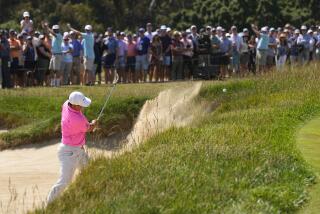Miller’s magic number: 63
- Share via
OAKMONT, PA. — He wasn’t sure what to expect when he stood on the driving range at Oakmont Country Club on June 17, 1973, before the final round of the U.S. Open. But Johnny Miller was dead certain about one thing. He was shaky.
Maybe it was because of the 76 he shot in the third round that dropped him six shots behind the 54-hole leaders -- Arnold Palmer, Julius Boros, Jerry Heard and John Schlee. Meanwhile, Tom Watson, Jack Nicklaus, Lee Trevino and Gary Player were all in front of him and Miller was feeling downright uneasy.
He wasn’t nervous about his competition or playing poorly. He was concerned about what else could go wrong; he had forgotten his yardage book the day before, on the way to his five-over-par 76.
“That put me over the edge,” he said. “I just went over the top emotionally. I was five over after six. I could have shot 80-something. It threw me right over the edge of my choke line.”
He got the yardage book in time to play the back nine Saturday, so Miller was still technically in the hunt when he arrived at the driving range Sunday morning, tied for 13th.
Miller made a pre-round adjustment in his stance. He had four balls left to hit in his bucket of practice balls and decided to open his stance way up. He started connecting solidly. He started to feel something like confidence.
Before heading to the first tee, he asked himself a question:
“Should I try this? What the heck, I got nothing to lose.”
And that’s how it all started, Miller’s improbable march to one of golf’s greatest achievements, his final-round 63 on the treacherous links of Oakmont, the lowest final-round score in history to win the U.S. Open.
He teed off an hour before the leaders, birdied the first four holes, then after three-putting the par-three eighth for a bogey, Miller went on a tear. He birdied the ninth, 11th, 12th and 13th, barely missed a birdie at the 14th and arrived at the 15th tee tied for the lead at four under.
At the 15th, a 453-yard par four where he had pars the first three rounds, Miller hit a four-iron to 10 feet, made the putt for birdie and took the lead.
Not long afterward, Palmer, playing with Schlee, hit a drive at the 12th hole, then took a look at the scoreboard and saw Miller was ahead.
“What the hell is Miller shooting?” Palmer asked Schlee.
It’s one of golf’s most enduring quotes.
Miller parred the 16th and lipped out birdie putts at the 17th and 18th for his eight-under 63. He waited to see if anyone could catch him. Schlee had the only chance, as it turned out, but he couldn’t get a 40-footer to drop at the 18th and Miller had his Open title with a five-under 279.
The greens had been softened by rain, but Miller’s feat was still remarkable. He hit every green in regulation, coaxed 10 of his iron shots to stop 15 feet or closer to the hole and needed only 29 putts.
Even a year later, the effects of Miller’s 63 were still being felt. At the 1974 U.S. Open at Winged Foot in Mamaroneck, N.Y., the United States Golf Assn. under Sandy Tatum came up with one of the most punishing setups in history. Hale Irwin won at seven over. The difficult course conditions were widely interpreted as fallout from Miller’s scorching final round the year before, although Tatum denied it then ... and still does.
“He was fibbing,” Miller said. “Every player I saw that week said, ‘Thanks a lot, Miller.’ ”
The 63 has since been matched in the U.S. Open, by Nicklaus and Tom Weiskopf in 1980 at Baltusrol in Springfield, N.J., but never in the final round to win.
It’s still a round that Miller, 59, is asked to recall more than ever, especially with the U.S. Open back at Oakmont.
He said he is content to let history judge whether it’s the greatest round ever, but Miller, as usual, has an opinion.
“I had a hall of fame group ahead of me,” he said. “It wasn’t like I was beating guys you never heard of.
“It’s the gold standard for a final-round performance that everything else will be measured against.”
More to Read
Go beyond the scoreboard
Get the latest on L.A.'s teams in the daily Sports Report newsletter.
You may occasionally receive promotional content from the Los Angeles Times.










